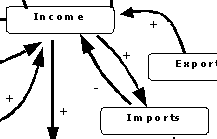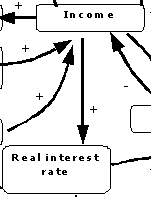| |
Contents
|
|
| |
|
|
| |
|
|
| |
|
|
| |
|
|
| |
|
|
| |
|
|
| |
|
|
| |
|
|
| |
|
|
| |
If
you have never heard of IS-LM model click here.
Freely
modifiable MS Word version of the graph.
Data
for all the variables in IS-LM model
|
|
| |
4.
Reading the scheme: two examples
To read the graph, you simply start from a variable, imposing a
change in a specified direction (increase or fall). Then, following
the arrows, you see the dynamics of the variables immediately involved,
depending on the sign you see: a plus sign means a change in the same
direction (increase or fall, respectively), whereas a minus sign
has the opposite meaning (fall or increase, respectively).
The impact will usually spread over time, since real processes need time
to take place - with the possible exception of financial and monetary
movements.
Similarly, the strength of the reaction in the second variable depends
on its responsiveness (elasticity)
to the first one. The relationships have variable strength; thus the reader
can single out what should be particularly responsive in order a certain
final effect to take place.
A caveat: All changes in variable levels will take place in the
expected direction provided that the other variables around are not changing
at the same time ("other things equal" clause). If this does
not hold, specific hypotheses on surrounding dynamics should be introduced.
Furthermore, the changes in the second-wave variables will exert subsequent
pressure on third-wave variables, until all variables in the graph have
been considered.
The longer the chain, the weaker the effects and the longer the time
delay since original source.
|
|
| 4.1.
Export-led growth |
|
|
Other things
equal, an increase of export will
trigger an increase of income. |
| The increase
in income gives rise to 6 main phenomena: |
|
|
1. an increase
of consumption, since households are
richer. Consumption growth, in turn, implies a further increase of income
(Keynesian multiplier); |
|
|
2. an increase
of employment, since more production
requires more labour; |
|
|
3. the
growing income helps the households, by increasing their savings;
4. the growing income helps the State, by widening the tax base, thus the
tax revenue. At normal levels of public
expenditure, this means a reduced deficit or even a surplus for the State
budget; |
|
|
5. it increases
imports; |
|
|
6. it also
produces an increase of the real interest
rate, given a fixed real money supply,
which in turn depends on a deliberate choice of the central bank not to
increase the nominal money supply (not to print money, not to allow more
credit from banks to the economy). |
| The rise
of real interest rate is a turning
point. |
|
|
The rise
of real interest rate depresses investment, which in turn brakes the income
growth.
|
The initial
export push on income is thus supported by consumption and restrained by
investment.
The state and the households are main beneficiaries, together with exporters,
while firms (especially producers of capital investment goods) are the losers. |
|
|
The increase
in the real interest rate has the further effect of increasing the nominal
exchange rate, by attracting foreign
capital. Thus the real exchange rate rise as well. With stronger domestic
currency, not only imports will further rise but also the exports will be
restrained. |
|
A second negative
loop is then emerged: a rise in exports will eventually be absorbed by
an increase of real exchange rate.
|
All this
depend on the policy of the central bank, which did not increase the nominal
money supply, leaving room for interest
rate to rise, depressing both investment and exports.
Export-led growth is unsustainable and short living, unless the central
bank accompanies the GDP growth with an expansionary monetary policy (larger
money supply), so to leave the interest rate at the previous level. |
|
|
If the
central bank acts and keep the interest rate under control, everybody is
happy: investment stay at the same level so as the exchange
rate, leaving room for export to continue their growth. |
|
|
Prolonged
GDP growth boost employment, as we
said, and this reduces unemployment.
To the extent wages are dependent on
unemployment, they will rise as well, increasing the cost of production.
This will exert a pressure on firms to rise prices - both in competitive
and monopolized markets. Inflation
becomes a real risk. |
|
|
The increase
of price level reduces the real money
supply: by definition the latter is nominal
money supply divided by price level.
Unless the central bank further increases the nominal money supply, the
real interest rate will rise, with all its unpleasant consequences on export
and investment. |
| Thus, expansionary
monetary policy risks to provoke inflation and a further need for money
supply expansion. |
|
[See
previous graph]
|
Unfortunately,
the price level increase is already braking exports by strengthening the
real exchange rate, given a stable world price level.
In other words, inflation is damaging
exports by increasing the price of domestic goods in foreign terms, even
in the event of a fixed nominal exchange rate or an expansion of money supply
that keep the real interest rate stable. |
|
If price level is extremely responsive
to unemployment, then the task of the central bank is very difficult,
since the export-led growth is in danger from different points of attack.
In synthesis, an export-led growth is possible but it requires a careful
policy of control in side effects that can menace to erode the basis of
the same spurring element: exports.
Crucial is the responsiveness of the variables to changes in the other
values. If investment is not really influenced by the interest rate (either
exports by the exchange rate), the export-led growth is clearly easier
to manage.
|
|
|
Looking
again at the graph, the export-led growth will be stronger and more sustainable:
i) the larger the share of exports on GDP;
ii) the stronger the Keynesian multiplier;
iii) the less the interest rate reacts
to income;
iv) the less the exchange rate reacts to the interest rate;
v) the less investment reacts to the interest rate;
vi) the less exports are responsive to exchange rate;
vii) the less are wages are responsive to unemployment;
viii) the less prices are responsive to wages;
ix) the less imports are responsive to income. |
|
We started our story from an increase of exports. But what could have
provoked it?
A first answer would be a growing foreign GDP with the widening foreign
imports it implies. Another would be the opening of new markets for domestic
goods abroad, due to marketing efforts of exporters.
Furthermore, it is possible that the export dynamics is the target of
conscious economic policies.
To the extent export-led growth is strong, a careful fiscal policy promoting
export may be a cute move, since tax
revenue will rise throughout the growth.
Alternatevely, a pre-emptive
expansionary policy by the central bank could provoke an export increase
through international price competitiveness of the country, improved by
a devaluation, prompted by the fall of interest rate, due in turn to the
increase in nominal (and real) money supply decided by the central bank.
In short, an export-led growth can be triggered by external and internal
reasons, accompanied and braked by internal conditions. As an alternative
to export-led growth, domestic pulled growth has been proposed as having
several advantages in this paper.
|
|
We invite the reader to try a similar description and interpretation of
a fiscal expansionary policy, relying on an increase in public
expenditure. Which will be the immediate and far-reaching consequences?
|












